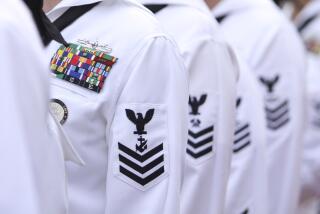Time Flies
- Share via
POINT MUGU — The Navy on Monday took one step closer to avoiding disaster when the clock ticks over to the year 2000.
Engineers at the weapons division of the Naval Air Warfare Center turned the clock ahead to 11:40 p.m. Dec. 31, 1999, sat down at their computer stations and counted down to the new year.
And as officials expected, the feared Y2K bug didn’t cause any computers--or planes--to crash.
“The best thing to happen in a Y2K test is nothing,” year 2000 program manager Debby Young said moments after the simulated New Year’s. “All the testing up to this point has been very successful.”
The test began at 9 a.m. when a P-3C surveillance plane took off from Point Mugu and flew over the Channel Islands. While monitoring the plane from a control room, engineers tested its computers, communications and radar systems. After simulating Jan. 1, they turned the clocks to Feb. 29, because 2000 is a leap year.
In the control room, engineers watched two big screens: one that tracked the plane’s flight path and one that showed a video from aboard the P-3C. Then the plane continued to China Lake, where it underwent more Y2K testing, and landed at Point Mugu at noon.
There were no glitches or problems in any of the tests, Young said. But she is still worried that not everyone is ready. For example, she said, if the power goes out, all the Navy’s planning will be useless.
Capt. Richard Ormsbee, vice commander of the warfare center’s weapons division, said Monday’s test was one of many simulations his Y2K team has conducted over the last three years. On separate occasions, Navy officials have tested the computers on the planes and in the control center. But Monday’s test showed that the two sets of computers should operate together without any problems.
*
Throughout the course of Y2K testing, Ormsbee said, engineers have found and fixed computers that weren’t ready for the new year.
“The Navy’s No. 1 priority right now is becoming Y2K compliant,” Ormsbee said. “We need to be able to fight the war on Jan. 1, 2000.”
But a new U.S. Senate report--scheduled to be released today--on the year 2000 software bug reportedly said that the Department of Defense is one of several governmental agencies behind the curve in preparation.
And Ormsbee said that although his division is almost ready, he will take advantage of the 305 days remaining to continue planning and testing. “Hope is not a strategy,” he said.
*
The Weapons Division includes Naval Air Weapons Stations in Point Mugu and China Lake. Point Mugu is primarily responsible for weapons testing and evaluation in a 36,000-square-mile area at sea, while China Lake conducts research and development and controls 1.1 million acres of testing ranges on land.
Rep. Elton Gallegly (R-Simi Valley), who visited Point Mugu during the Y2K test, said the sea range is another example of something very difficult for the Navy to duplicate.
He praised Point Mugu officials for tackling the year 2000 bug early.
“I don’t think any of us should be overconfident in saying that it’s not a problem,” Gallegly said.
Randy Langham, head of the sea range, said he was pleased with the test results.
“Nobody really knows what’s going to happen in 10 months,” Langham said. “But from all appearances, it looked like we had a very successful test. Certainly we didn’t have any dramatic problems. Now we’re going to make sure we don’t have any subtle problems.”
More to Read
Sign up for Essential California
The most important California stories and recommendations in your inbox every morning.
You may occasionally receive promotional content from the Los Angeles Times.













